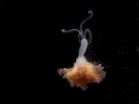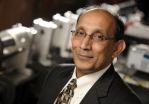(Press-News.org) How do bone-eating worms reproduce? A new study by Norio Miyamoto and colleagues from the Japan Agency for Marine-Earth Science and Technology sheds light on this question through a detailed observation of the postembryonic development and sexual maturation of Osedax worms, also known as "zombie worms." These worms typically inhabit vertebrate bones on the seafloor. The study is published online in Springer's journal Naturwissenschaften - The Science of Nature.
Osedax is Latin for "bone-devourer," which refers to how the worms bore into the bones of whale carcasses to reach enclosed fats and oils, on which they rely for sustenance. The first two species of Osedax were discovered by scientists in 2002. To date, information about the postembryonic development of these marine worms, Osedax species, is lacking. In order to understand their development and maturation, Miyamoto and team induced settlement of the bone-eating worm's larvae (Osedax japonicus specifically) by adding small pieces of whale bone to the petri dishes in which they were cultivating the larvae. After a period of time, they dissected the bones to observe the juvenile worms.
The researchers witnessed the whole development process of the worms, including the duration of the larval stage, the development of typically small, dwarf males and the maturation time in this species. They found that females started to spawn eggs six weeks after settlement. This rapid sexual maturation of females, alongside the male dwarfism which was observed, enables the worms to reproduce effectively in the food-rich, but highly isolated habitat of whale bones.
Dr. Miyamoto said, "Our findings provide essential information on the reproductive strategy of Osedax worms. Osedax japonicus are a promising model organism with which to address the evolution and development of these so-called bone-eating worms."
INFORMATION:
Reference
Miyamoto N et al (2013). Postembryonic Development of Bone-eating Worm Osedax japonicus. Naturwissenschaften – The Science of Nature; DOI 10.1007/s00114-013-1024-7
The full-text article and four color photos are available to journalists on request.
Mystery of 'zombie worm' development unveiled
New study elucidates the reproductive strategy of bone-eating worms
2013-03-12
ELSE PRESS RELEASES FROM THIS DATE:
Neural 'synchrony' may be key to understanding how the human brain perceives
2013-03-12
Despite many remarkable discoveries in the field of neuroscience during the past several decades, researchers have not been able to fully crack the brain's "neural code." The neural code details how the brain's roughly 100 billion neurons turn raw sensory inputs into information we can use to see, hear and feel things in our environment.
In a perspective article published in the journal Nature Neuroscience on Feb. 25, 2013, biomedical engineering professor Garrett Stanley detailed research progress toward "reading and writing the neural code." This encompasses the ability ...
4 dinosaur egg species identified in Lleida
2013-03-12
A study headed by the Miquel Crusafont Catalan Palaeontology Institute has for the first time documented detailed records of dinosaur egg fossils in the Coll de Nargó archaeological site in Lleida, Spain. Up until now, only one type of dinosaur egg had been documented in the region.
The archaeological site in Coll de Nargó containing dinosaur eggs lies some 8 kilometres to the west of the town that bears the same name in the province of Lleida. This region is home to different types of geological formations, including the Areniscas de Arén Formation and the Tremp Formation, ...
Does expressing anger on online rant-sites make you feel better or worse?
2013-03-12
New Rochelle, NY, March 12, 2013—Little is known about the value and emotional consequences of expressing anger on the Internet. Rant-sites provide an outlet for anonymous, angry outbursts. How people feel after reading and writing rants and the effects of this behavior is explored in an article in Cyberpsychology, Behavior, and Social Networking, (http://www.liebertpub.com/cyber) a peer-reviewed journal from Mary Ann Liebert, Inc., publishers (http://www.liebertpub.com). The article is available online on the Cyberpsychology, Behavior, and Social Networking (http://www.liebertpub.com/cyber) ...
Young pigs prefer traditional soybean diet
2013-03-12
Des Moines, IA – Pigs aren't known for being picky, but new research shows they avoid bitter tastes when they can.
In a new study of nursery pig diets, researchers from the University of Alberta offered pigs different amounts of soybean meal, napus canola meal and juncea canola meal. They found that pigs ate more soybean meal when given a choice.
Napus canola meal and juncea canola meal come from rapeseed and mustard greens, respectively. Canola meals are less expensive than soybean meal. If producers can replace soybean meal in swine diets, they could produce pork ...
Updated 'stereo EEG' workflow simplifies planning of epilepsy surgery
2013-03-12
Philadelphia, Pa. (March 12, 2013) – For patients with "drug-resistant" epilepsy requiring surgery, an updated stereoelectroencephalography (SEEG) technique provides a more efficient process for obtaining critical data for surgical planning, according to a study in the March issue of Neurosurgery, official journal of the Congress of Neurological Surgeons. The journal is published by Lippincott Williams & Wilkins, a part of Wolters Kluwer Health.
"SEEG is a safe and accurate procedure for invasive assessment of the epileptogenic zone," according to the new report by Dr. ...
Some bacteria may protect against disease caused by stomach infection
2013-03-12
Half of the world's human population is infected with the stomach bacteria called Helicobacter pylori, yet it causes disease in only about 10 percent of those infected. Other bacteria living in the stomach may be a key factor in whether or not H. pylori causes disease, according to a new study led by scientists at the University of California, Santa Cruz.
"People tend to think of the stomach as a relatively sterile environment, but it's actually populated with microbes," said Karen Ottemann, professor and chair of microbiology and environmental toxicology at UC Santa ...
Nearly a third of antibiotic prescriptions for dialysis patients inappropriate
2013-03-12
Patients who receive hemodialysis are at a significant risk of developing infections, a leading cause of hospitalization and death in this patient population. A new study highlights the need to improve antibiotic use in outpatient dialysis facilities as data shows nearly a third of antibiotic prescriptions are deemed inappropriate. The study is published in the April issue of Infection Control and Hospital Epidemiology, the journal of the Society for Healthcare Epidemiology of America.
The United States Renal Data System reported that from 1993 to 2010, the number of ...
Computer model may help athletes and soldiers avoid brain damage and concussions
2013-03-12
Concussions can occur in sports and in combat, but health experts do not know precisely which jolts, collisions and awkward head movements during these activities pose the greatest risks to the brain. To find out, Johns Hopkins engineers have developed a powerful new computer-based process that helps identify the dangerous conditions that lead to concussion-related brain injuries. This approach could lead to new medical treatment options and some sports rule changes to reduce brain trauma among players.
The research comes at a time when greater attention is being paid ...
BUSM study reveals therapeutic targets to alter inflammation, type 2 diabetes
2013-03-12
New research from Boston University School of Medicine (BUSM) reveals that B cells regulate obesity-associated inflammation and type 2 diabetes through two specific mechanisms. The study, published in the Proceedings of the National Academies of Sciences, indicates the importance of continuing to explore B cells as a therapeutic target to treat these diseases. Barbara Nikolajczyk, PhD, associate professor of microbiology at BUSM, is the study's senior author.
The incidence of diabetes continues to rise at alarming rates. According to the National Institute of Diabetes ...
Sri Lankan snake study reveals new species, rich biodiversity in island country
2013-03-12
WASHINGTON Alex Pyron's expertise is in family trees. Who is related to whom, who begat whom, how did they get where they are now. But not for humans: reptiles.
In 2011, his fieldwork in Sri Lanka studying snake diversity on the island led him to confirm the identity of 60 known species of snakes. With Sri Lankan collaborators, Ruchira Somaweera, an author on snakes and expert on amphibians and reptiles, and Dushantha Kandambi, a local naturalist and snake expert, the team collected 60 species of snakes and of those, Dr. Pyron used DNA sequencing technology on 40 of them. ...
LAST 30 PRESS RELEASES:
Boosting the cell’s own cleanup
Movement matters: Light activity led to better survival in diabetes, heart, kidney disease
Method developed to identify best treatment combinations for glioblastoma based on unique cellular targets
Self-guided behavioral app helps children with epilepsy sleep earlier
Higher consumption of food preservatives is associated with an increased risk of type 2 diabetes
NTU Singapore-led team captures first-ever ‘twitch’ of the eye’s night-vision cells as they detect light, paving the way for earlier detection of blindness-causing diseases
Global aviation emissions could be halved through maximising efficiency gains, new study shows
Fewer layovers, better-connected airports, more firm growth
Exposure to natural light improves metabolic health
As we age, immune cells protect the spinal cord
New expert guidance urges caution before surgery for patients with treatment-resistant constipation
Solar hydrogen can now be produced efficiently without the scarce metal platinum
Sleeping in on weekends may help boost teens’ mental health
Study: Teens use cellphones for an hour a day at school
After more than two years of war, Palestinian children are hungry, denied education and “like the living dead”
The untold story of life with Prader-Willi syndrome - according to the siblings who live it
How the parasite that ‘gave up sex’ found more hosts – and why its victory won’t last
When is it time to jump? The boiling frog problem of AI use in physics education
Twitter data reveals partisan divide in understanding why pollen season's getting worse
AI is quick but risky for updating old software
Revolutionizing biosecurity: new multi-omics framework to transform invasive species management
From ancient herb to modern medicine: new review unveils the multi-targeted healing potential of Borago officinalis
Building a global scientific community: Biological Diversity Journal announces dual recruitment of Editorial Board and Youth Editorial Board members
Microbes that break down antibiotics help protect ecosystems under drug pollution
Smart biochar that remembers pollutants offers a new way to clean water and recycle biomass
Rice genes matter more than domestication in shaping plant microbiomes
Ticking time bomb: Some farmers report as many as 70 tick encounters over a 6-month period
Turning garden and crop waste into plastics
Scientists discover ‘platypus galaxies’ in the early universe
Seeing thyroid cancer in a new light: when AI meets label-free imaging in the operating room
[Press-News.org] Mystery of 'zombie worm' development unveiledNew study elucidates the reproductive strategy of bone-eating worms




